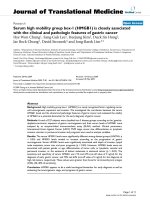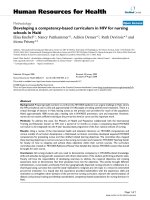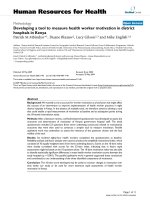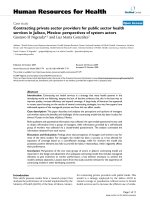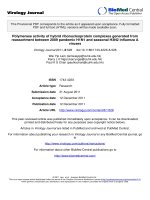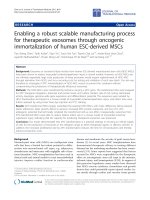Báo cáo sinh học: " Motavizumab, A Neutralizing Anti-Respiratory Syncytial Virus (Rsv) Monoclonal Antibody Significantly Modifies The Local And Systemic Cytokine Responses Induced By Rsv In The Mouse Model" pdf
Bạn đang xem bản rút gọn của tài liệu. Xem và tải ngay bản đầy đủ của tài liệu tại đây (288.77 KB, 5 trang )
BioMed Central
Page 1 of 5
(page number not for citation purposes)
Virology Journal
Open Access
Short report
Motavizumab, A Neutralizing Anti-Respiratory Syncytial Virus
(Rsv) Monoclonal Antibody Significantly Modifies The Local And
Systemic Cytokine Responses Induced By Rsv In The Mouse Model
Asunción Mejías
1
, Susana Chávez-Bueno
1
, Martin B Raynor
1
,
John Connolly
2
, Peter A Kiener
3
, Hasan S Jafri
1
and Octavio Ramilo*
1
Address:
1
Department of Pediatrics, Division of Pediatric Infectious Diseases, University of Texas Southwestern Medical Center at Dallas, Texas,
USA,
2
Baylor Institute for Immunology and Research at Dallas, Texas, USA and
3
MedImmune Inc, Gaithersburg, MD, USA
Email: Asunción Mejías - ; Susana Chávez-Bueno - ;
Martin B Raynor - ; John Connolly - ;
Peter A Kiener - ; Hasan S Jafri - ;
Octavio Ramilo* -
* Corresponding author
Abstract
Motavizumab (MEDI-524) is a monoclonal antibody with enhanced neutralizing activity against RSV.
In mice, motavizumab suppressed RSV replication which resulted in significant reduction of clinical
parameters of disease severity. We evaluated the effect of motavizumab on the local and systemic
immune response induced by RSV in the mouse model. Balb/c mice were intranasally inoculated
with 10
6.5
PFU RSV A2 or medium. Motavizumab was given once intraperitoneally (1.25 mg/mouse)
as prophylaxis, 24 h before virus inoculation. Bronchoalveolar lavage (BAL) and serum samples
were obtained at days 1, 5 (acute) and 28 (long-term) post inoculation and analyzed with a multiplex
assay (Beadlyte Upstate, NY) for simultaneous quantitation of 18 cytokines: IL-1α, IL-1β, IL-2, IL-
3, IL-4, IL-5, IL-6, KC (similar to human IL-8), IL-10, IL-12p40, IL-12p70, IL-13, IL-17, TNF-α, MCP-
1, RANTES, IFN-γ and GM-CSF. Overall, cytokine concentrations were lower in serum than in BAL
samples. By day 28, only KC was detected in BAL specimens at low concentrations in all groups.
Administration of motavizumab significantly reduced (p < 0.05) BAL concentrations of IL-1α, IL-
12p70 and TNF-α on day 1, and concentrations of IFN-γ on days 1 and 5 compared with RSV-
infected untreated controls. In the systemic compartment, the concentrations of IL-10, IFN-γ and
KC were significantly reduced in the motavizumab-treated mice compared with the untreated
controls. In summary, prophylactic administration of motavizumab was associated with significant
reductions on RSV replication and concentrations of cytokine and chemokines, which are likely
related to the improvement observed in clinical markers of disease severity.
Findings
Respiratory Syncytial Virus (RSV) is the main viral respira-
tory pathogen causing hospitalization in infants and
young children worldwide[1]. It infects nearly 70% of
infants in their first year of life and almost all children by
the age of two [2]. The mechanisms by which RSV causes
pulmonary disease and more specifically which factors
determine disease severity still remains to be fully charac-
Published: 25 October 2007
Virology Journal 2007, 4:109 doi:10.1186/1743-422X-4-109
Received: 11 August 2007
Accepted: 25 October 2007
This article is available from: />© 2007 Mejías et al; licensee BioMed Central Ltd.
This is an Open Access article distributed under the terms of the Creative Commons Attribution License ( />),
which permits unrestricted use, distribution, and reproduction in any medium, provided the original work is properly cited.
Virology Journal 2007, 4:109 />Page 2 of 5
(page number not for citation purposes)
terized. It is increasingly appreciated that symptoms and
signs of RSV are caused not only by the direct viral cyto-
pathic effect but also by the host response to infection.
Nonetheless, in RSV disease both viral replication and the
exaggerated immune response to RSV infection are closely
interrelated. In fact, studies suggest that the pattern of
cytokine production elicited by RSV affects the balance
between virus replication and disease pathogenesis, that
ultimately determines the manifestations of the disease
[3].
In the present study we took an alternative approach to
explore the relative importance and role that different
cytokines and chemokines play in acute RSV disease sever-
ity.
Instead of targeting individual cytokines as potential ther-
apeutic targets, we took advantage of our experience with
motavizumab. We previously showed that the superior
neutralizing activity of this anti-RSV monoclonal anti-
body compared with palivizumab was associated with fur-
ther reductions in RSV replication which in turn resulted
in additional improvement in clinical disease severity
[4,5]. The present study was designed to assess the effect
of motavizumab on the cytokine and chemokine
responses induced by RSV both in the respiratory tract and
in the systemic compartment, which, we hypothesized,
were likely associated with the observed improvement in
disease severity.
Seven-week-old female, pathogen-free BALB/c mice
(Charles River) were intranasally inoculated with 100 µL
of 10
6.5
PFU RSV-A2 or sterile 10% Eagle's minimal essen-
tial medium, following institutional guidelines [5-7].
Motavizumab was administered intraperitoneally 24 h
before RSV inoculation (1.25 mg in 0.1 ml of PBS/per
mouse) [5]. Our previous studies showed that no treat-
ment or treatment with either PBS or an IgG1 isotype-
matched control antibody, MEDI-507, at the same time of
the administration of the anti-RSV antibody had no effect
on the cytokine profile or other clinical and inflammatory
parameters evaluated, therefore those controls were not
included in the study [8]. Bronchoalveolar lavage (BAL)
and serum samples from 4–6 mice per time point/group
from two independent experiments were obtained during
the acute, (days 1 and 5 post-inoculation) and chronic
(day 28) phases of the disease. Paired BAL and serum sam-
ples from non-infected controls, RSV-infected untreated,
and RSV-infected mice treated with motavizumab previ-
ously stored at -80°C, were randomly selected within the
two experiments (4 mice per time-point/group) for
cytokine analysis using the Beadlyte Mouse Multi-
Cytokine Detection System (Upstate Biotechnology, Lake
Placid NY) and the Luminex
100
plate reader (Luminex
Corporation, Austin, TX) according to manufacturer's
instructions. Quantification of cytokines was performed
by regression analysis from a standard curve generated
from cytokine standards included in the kit with a lower
limit of detection of 10 pg/ml for all cytokines evaluated.
The plaque assay, which has a lower limit of detection of
1.7 log
10
PFU/mL, was used to measure RSV viral loads in
BAL specimens as previously described [5-7]. Disease
severity was assessed by whole-body plethysmograph
(Buxco, Troy, NY) to evaluate airway obstruction (AO) by
measuring the enhanced pause [7-9]. According to data
distribution, Mann-Whitney rank sum test or t-test were
used for analyses. Since the concentrations of the
cytokines/chemokines evaluated were detected either at a
very low level or were below the level of detection of the
assay in the non-infected control group, and the objective
of the study was to evaluate the effect of motavizumab in
the inflammatory response induced by RSV, the unin-
fected control group was not included in the statistical
analyses.
Motavizumab prophylaxis completely prevented the
development of clinical disease objectively assessed by
measuring the AO; in fact, mice treated with the mAb
remained clinically asymptomatic throughout the experi-
ment compared with the RSV-infected untreated mice
(Figure 1). Furthermore, motavizumab administration
resulted in significant reductions of RSV loads compared
Effect of the anti-RSV mAb (motavizumab) on pulmonary functionFigure 1
Effect of the anti-RSV mAb (motavizumab) on pul-
monary function. Airway obstruction was assessed by
whole body plethysmograph by measuring basal Penh daily
during the first two weeks after infection and weekly up to
day 28. Values represent median; errors bars, 25
th
–75
th
per-
centile. Each group consisted of 8 mice. Results of two sepa-
rate experiments are shown. * p < 0.001 by Kruskal-Wallis
ANOVA on ranks for comparison between RSV-infected
untreated, sham inoculated controls and RSV-infected
treated with motavizumab at -24 h.
infected Controls Non-
Days after RSV Inoculation
n= 8
RSV
-
infected Controls
RSV MEDI -24h
02468
1
12 28
*
p<0.001 vs RSV
infected
*
*
n= 8
Non-Infected Controls
Infected Controls
RSV MEDI -24h
02468
1
12
*
p<0.001 vs RSV-
infected
*
*
2.52.5
2.02.0
Basal Penh
1.51.5
1.01.0
0.50.5
Days after RSV Inoculation
Virology Journal 2007, 4:109 />Page 3 of 5
(page number not for citation purposes)
with untreated controls on days 1 and 5 (< 1.7 PFU/ml
log
10
vs 2.45 [2.22–2.53] on day 1 and 3.12 [2.73–3. 39]
on day 5; p < 0.05).
Eighteen cytokines, including interleukins (IL)-1α, -1β, -
2, -3, -4, -5, -6, KC (similar to human IL-8), IL-10, -12p40/
70, -13, -17, tumor necrosis factor-α (TNF-α), macro-
phage chemoattractant protein-1 (MCP-1), Regulated
upon Activation, Normal T-cell Expressed and Secreted
(RANTES), interferon-γ (IFN-γ) and granulocyte macro-
phage colony-stimulating factor (GM-CSF) were meas-
ured using a multiplex antibody assay. Except for IL-10,
MCP-1, IL-1β and IL-12p70 concentrations, the effect of
motavizumab on the cytokine profile was more evident in
the respiratory tract (BAL) than in serum. This could be
explained in part because fewer cytokines were detected in
serum and also because the concentrations were lower in
serum than in BAL specimens.
On day 1, BAL concentrations of IL-1α, IL-12p70, TNF-α
and IFN-γ and serum IL-10 and KC were significantly
lower in mice treated with motavizumab compared with
RSV-infected untreated mice (Table 1). The role of TNF-α
in RSV disease is not completely understood. While some
authors have suggested that TNF-α has a protective role in
RSV infection, others have related the RSV-induced lung
damage to the overproduction of TNF-α [10,11]. In our
previous studies, palivizumab administration did not
modify BAL concentrations of TNF-α nor the initial peak
of airway obstruction (AO) observed in this model [8]. In
contrast, motavizumab significantly reduced BAL concen-
trations of TNF-α, and this was unexpectedly associated
with suppression of the initial peak of AO on day 1.
Although the pathogenesis of the first peak of AO in this
model is not completely understood, this is the first time
that we observed its suppression, suggesting that early
production of TNF-α may play a major role in initiating
airway disease.
Our previous studies showed that tracheal aspirate con-
centrations of RANTES, IL-8 and IL-10 in children intu-
bated with severe RSV inversely correlated with clinical
disease severity, however these cytokines were not meas-
ured in serum [12]. Interleukin-10, an anti-inflammatory/
regulatory cytokine, has been shown not only to be an
important component of the pathogenesis of acute RSV
bronchiolitis but to also play a role in the enhanced air-
way hyperreactivity that occurs after RSV infection
[13,14]. In our study, motavizumab significantly
decreased serum concentrations of KC (chemoattractant
for neutrophils, the predominant lung inflammatory cell
during acute RSV) and IL-10, two cytokines that play a
major role in the pathogenesis of RSV bronchiolitis [13].
BAL concentrations of IL-6, RANTES and MCP-1 were also
decreased in the motavizumab group, but likely due to
small numbers there was insufficient power to achieve sta-
tistical significance (Tables 1, 2).
On day 5, the peak of viral replication and lung inflamma-
tion in this model, both serum and BAL concentrations of
INF-γ were significantly decreased in the motavizumab
group (Table 2). To date, there is still no consensus on the
role of INF-γ in RSV pathogenesis and its responses may
vary depending on disease severity [15-17]. Mice treated
with motavizumab had no virus detected by culture in the
respiratory tract, (< 1.7 PFU/mL log
10
) and this reduction
in virus load was associated with significantly decreased
local and systemic IFN-γ concentrations, and more impor-
tantly with no evidence of AO in these mice suggesting a
pivotal role of INF-γ in the pathogenesis of RSV disease.
Table 1: BAL/serum cytokine concentrations (pg/mL) in RSV infected mice treated with motavizumab compared with untreated RSV
infected controls on day 1
after inoculation. Each group consisted of 4 samples randomly selected from two independent experiments.
BAL (D1) SERUM (D1)
RSV Untreated RSV Motavizumab p value RSV Untreated RSV motavizumab p value
IFN-γ 67.16 ± (24.6) 28.01 ± (13.8) 0.03 ND ND
MCP-1 1930.68 ± (716.6) 1088.12 ± (307.8) 0.07 381.83 (341.0–554.8) 230.65 (217.43–298.83) 0.6
RANTES 1952.10 ± (999.05) 671.66 ± (340.4) 0.051 ND ND
IL-10 39.29 ± (27.0) 14.47 ± (7.8) 0.1 102.23 ± (22.5) 16.78 ± (13.56) 0.001
TNF-α 2290.90 ± (1100.2) 279.03 ± (204.7) 0.01 ND ND
GM-CSF 101.42 (45.7–144.9) 25.14 (22.1–34.0) 0.1 ND ND
IL-12p70 44.14 ± (13.5) 22.59 ± (8.7) 0.03 45.85 ± (17.5) 23.75 ± (16.1) 0.16
KC 3967.43 (2039.8–5795.3) 1303.57 (946.4–1657.1) 0.1 215.86 ± (125.8) 37.63 ± (32.5) 0.03
IL-6 2580.89 ± (1413.6) 821.79 ± (290.13) 0.051 91.39 (45.43–135.31) 31.17 (18.97–35.85) 0.2
IL-1β 477.52 (231.53–831.92) 182.78 (179.4–214.3) 0.3 266.88 ± (74.4) 119.70 ± (143.5) 0.16
IL-1α 289.75 ± (114.0) 76.28 ± (29.1) 0.01 ND ND
IL-17 ND ND 20.68 (11.94–31.85) 10.67 (10.06–12.03) 0.2
Note: Data are shown as mean ± SD, or medians and 25–75% range as appropriate according to whether they were normally distributed. ND (non-
detected)
Virology Journal 2007, 4:109 />Page 4 of 5
(page number not for citation purposes)
The fact that substantial IFN-γ was detected on day 5
despite treatment with the mAb suggests that some viral
particles still escaped the effect of the enhanced neutraliz-
ing antibody. This interpretation of the results is further
supported by our previous experiments in which UV-inac-
tivated virus did not induce an INF-γ response [7].
By day 28, only KC was detected in BAL specimens at low
concentrations without significant differences between
groups.
Taking together, these results suggest that not only the
local but also the systemic cytokine immune response
influence the severity of acute RSV disease, and that RSV
clinical disease can be modified with the use of a specific
anti-RSV neutralizing antibody directed against a well
conserved epitope of the RSV F protein.
In summary, in the mouse model, prophylactic adminis-
tration of motavizumab significantly decreased RSV repli-
cation, the local and systemic cytokine responses,
especially TNFα, IL-1α, IL-12p70, KC, IL-10 and INF-γ,
and completely prevented the development of clinical
acute RSV disease. Future studies in humans treated with
anti-RSV antibodies should determine whether changes in
clinical markers of disease severity correlate with similar
changes in cytokine profiles. These studies will provide
further understanding of the pathogenesis of RSV infec-
tion and should help identifying new targets for develop-
ing immunomodulatory therapies.
Competing interests
O.R. and H.J. serve as members of the Medimmune Pedi-
atric Infectious Disease Advisory Board. OR, HJ and AM
have received research grants from Medimmune and P.K.
is an employee of Medimmune.
Authors' contributions
A.M study design, data analyses, manuscript preparation;
SCB data analyses and manuscript review, and MBR per-
forming experiments; JC Luminex data analysis and inter-
pretation. PK and HSJ data interpretation; OR project
design, experimental analyses and interpretation, manu-
script preparation.
Acknowledgements
The study was supported in part by a research grant by MedImmune Inc (to
O.R). A.M. is supported in part by the Pediatric Fellowship Award in Viral
Respiratory Infectious Diseases supported by MedImmune Inc., at the PAS-
SPR Annual Meeting and the RGK Foundation Fellowship Award in Infec-
tious Diseases at Children's Medical Center Dallas. S.C.B. is supported in
part by a Pediatric Infectious Disease Society Fellowship Award sponsored
by GlaxoSmithKline Pharmaceuticals. H.S.J. is supported in part by the
National Institute of Child Health and Human Development, Grant
HD046000, the Pediatric Pharmacology Research Unit Network. OR is
supported in part by research grants from the NIH 1U19AI057234-010003
and 1R21 AI054990-01A2 and DANA Foundation.
References
1. Peebles RS Jr., Sheller JR, Collins RD, Jarzecka AK, Mitchell DB,
Parker RA, Graham BS: Respiratory syncytial virus infection
does not increase allergen- induced type 2 cytokine produc-
tion, yet increases airway hyperresponsiveness in mice. J Med
Virol 2001, 63(2):178-188.
2. Shay DK, Holman RC, Newman RD, Liu LL, Stout JW, Anderson LJ:
Bronchiolitis-associated hospitalizations among US children,
1980-1996. Jama 1999, 282(15):1440-1446.
3. Alvarez R, Harrod KS, Shieh WJ, Zaki S, Tripp RA: Human metap-
neumovirus persists in BALB/c mice despite the presence of
neutralizing antibodies. J Virol 2004, 78(24):14003-14011.
4. Wu H, Pfarr DS, Tang Y, An LL, Patel NK, Watkins JD, Huse WD,
Kiener PA, Young JF: Ultra-potent Antibodies Against Respira-
tory Syncytial Virus: Effects of Binding Kinetics and Binding
Valence on Viral Neutralization. J Mol Biol 2005.
5. Mejias A, Chavez-Bueno S, Rios AM, Aten MF, Raynor B, Peromingo
E, Soni P, Olsen KD, Kiener PA, Gomez AM, Jafri HS, Ramilo O:
Comparative effects of two neutralizing anti-respiratory syn-
cytial virus (RSV) monoclonal antibodies in the RSV murine
model: time versus potency. Antimicrob Agents Chemother 2005,
49(11):4700-4707.
Table 2: BAL/serum cytokine concentrations in RSV infected mice treated with motavizumab compared with untreated RSV infected
controls on day 5
after inoculation. Each group consisted of 4 samples randomly selected from two independent experiments.
BAL (D5) SERUM (D5)
RSV Untreated RSV Motavizumab p value RSV Untreated RSV Motavizumab p value
IFN-γ 1291.29 ± (561.3) 640.84 ± (388.8) 0.02 116.58 ± (43.1) 28.29 ± * (35.7) 0.02
MCP-1 291.10 ± (128.6) 132.0 ± (105.8) 0.15 311.95 ± (78.3) 343.26 ± (81.2) 0.6
RANTES 118.82 ± (28.3) 48.50 ± (51.9) 0.055 ND ND
IL-10 59.7 ± (52.91) 25.68 ± (18.5) 0.3 15.18 (10.0–71.9) 23.28 (15.18–48.82) 0.6
TNF-α 13.65 (10.32–17.35) 10.0 (10.0–11.18) 0.2 ND ND
IL-12p70 ND ND 39.72 ± (20.6) 38.07 ± (5.8) 0.7
IL-8 (KC) 209.9 ± (88.8) 117.75 ± (54.2) 0.12 32.54 ± (27.96) 25.82 ± (19.6) 0.7
IL-6 101.38 ± (51.22) 30.46 ± (28.87) 0.052 ND ND ND
IL-1β 34.63 ± (34.59) 52.25 ± (54.3) 0.6 180.66 ± (87.03) 126.09 ± (58.3) 0.4
IL-1α 12.59 ± (3.05) 13.84 ± (3.7) 0.6 ND ND ND
IL-17 ND ND 13.02 (10.0–22.98) 10.61 (10.0–11.77) 0.5
Note: Data are shown as mean ± SD, or medians and 25–75% range as appropriate according to whether they were normally distributed. ND (non-
detected).
Publish with Bio Med Central and every
scientist can read your work free of charge
"BioMed Central will be the most significant development for
disseminating the results of biomedical research in our lifetime."
Sir Paul Nurse, Cancer Research UK
Your research papers will be:
available free of charge to the entire biomedical community
peer reviewed and published immediately upon acceptance
cited in PubMed and archived on PubMed Central
yours — you keep the copyright
Submit your manuscript here:
/>BioMedcentral
Virology Journal 2007, 4:109 />Page 5 of 5
(page number not for citation purposes)
6. Chavez-Bueno S, Mejias A, Gomez AM, Olsen KD, Rios AM, Fonseca-
Aten M, Ramilo O, Jafri HS: Respiratory syncytial virus-induced
acute and chronic airway disease is independent of genetic
background: An experimental murine model. Virol J 2005,
2(1):46.
7. Jafri HS, Chavez-Bueno S, Mejias A, Gomez AM, Rios AM, Nassi SS,
Yusuf M, Kapur P, Hardy RD, Hatfield J, Rogers BB, Krisher K, Ramilo
O: Respiratory syncytial virus induces pneumonia, cytokine
response, airway obstruction, and chronic inflammatory
infiltrates associated with long-term airway hyperrespon-
siveness in mice. J Infect Dis 2004, 189(10):1856-1865.
8. Mejias A, Chavez-Bueno S, Rios AM, Saavedra-Lozano J, Fonseca Aten
M, Hatfield J, Kapur P, Gomez AM, Jafri HS, Ramilo O: Anti-respira-
tory syncytial virus (RSV) neutralizing antibody decreases
lung inflammation, airway obstruction, and airway hyperre-
sponsiveness in a murine RSV model. Antimicrob Agents Chem-
other 2004, 48(5):1811-1822.
9. Chunn JL, Young HW, Banerjee SK, Colasurdo GN, Blackburn MR:
Adenosine-dependent airway inflammation and hyperre-
sponsiveness in partially adenosine deaminase-deficient
mice. J Immunol 2001, 167(8):4676-4685.
10. Neuzil KM, Tang YW, Graham BS: Protective Role of TNF-alpha
in respiratory syncytial virus infection in vitro and in vivo. Am
J Med Sci 1996, 311(5):201-204.
11. Hussell T, Pennycook A, Openshaw PJ: Inhibition of tumor necro-
sis factor reduces the severity of virus-specific lung immun-
opathology. Eur J Immunol 2001, 31(9):2566-2573.
12. Sheeran P, Jafri H, Carubelli C, Saavedra J, Johnson C, Krisher K,
Sanchez PJ, Ramilo O: Elevated cytokine concentrations in the
nasopharyngeal and tracheal secretions of children with res-
piratory syncytial virus disease. Pediatr Infect Dis J 1999,
18(2):115-122.
13. Alonso Fernandez J, Roine I, Vasquez A, Caneo M: Soluble inter-
leukin-2 receptor (sCD25) and interleukin-10 plasma con-
centrations are associated with severity of primary
respiratory syncytial virus (RSV) infection. Eur Cytokine Netw
2005, 16(1):81-90.
14. Makela MJ, Kanehiro A, Dakhama A, Borish L, Joetham A, Tripp R,
Anderson L, Gelfand EW: The failure of interleukin-10-deficient
mice to develop airway hyperresponsiveness is overcome by
respiratory syncytial virus infection in allergen-sensitized/
challenged mice. Am J Respir Crit Care Med 2002, 165(6):824-831.
15. Aberle JH, Aberle SW, Dworzak MN, Mandl CW, Rebhandl W, Voll-
nhofer G, Kundi M, Popow-Kraupp T: Reduced interferon-
gamma expression in peripheral blood mononuclear cells of
infants with severe respiratory syncytial virus disease. Am J
Respir Crit Care Med 1999, 160(4):1263-1268.
16. Garofalo RP, Patti J, Hintz KA, Hill V, Ogra PL, Welliver RC: Macro-
phage inflammatory protein-1alpha (not T helper type 2
cytokines) is associated with severe forms of respiratory syn-
cytial virus bronchiolitis. J Infect Dis 2001, 184(4):393-399.
17. van Schaik SM, Obot N, Enhorning G, Hintz K, Gross K, Hancock GE,
Stack AM, Welliver RC: Role of interferon gamma in the patho-
genesis of primary respiratory syncytial virus infection in
BALB/c mice [In Process Citation]. J Med Virol 2000,
62(2):257-266.
